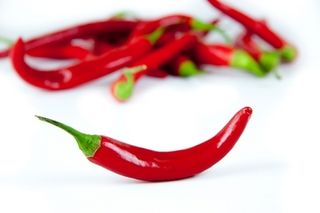Birthplace of Chili Pepper Farming Revealed

Chili peppers reign as the world's most widely cultivated spice crop; farmers grow them in bulk, and self-described chili-heads breed ever-spicier varieties of the fruit. But before they conquered cuisines around the globe, chili peppers were domesticated in Central and South America.
Now, scientists say they've found the hotspot where ancient farmers first cultivated Capsicum annuum, the most common kind of chili pepper.
By drawing on genetic, archaeological, linguistic and ecological evidence, the researchers found that chili farming was born in central-east Mexico. [Myth or Truth? 7 Ancient Health Ideas Explained]
"Identifying the origin of the chili pepper is not just an academic exercise," senior author of the study Paul Gepts, a plant scientist at the University of California, Davis, said in a statement. "By tracing back the ancestry of any domesticated plant, we can better understand the genetic evolution of that species and the origin of agriculture — a major step in human evolution in different regions of the world."
Genetic material from dozens of samples of farm-raised and wild chili peppers seemed to point to northeastern Mexico as the origin of domestication for C. annuum, the researchers found. But the scientists also looked at archaeological evidence for the peppers and ecological predictions of where the plant might have grown in climates of the past. They even looked at which ancient vocabularies included words for chili peppers. When these factors were taken into consideration, the birthplace of chili agriculture shifted farther south, to Mexico's central-east region.
Christine Hastorf, a researcher at the University of California, Berkeley, who studies ancient humans' use of plants, says combining multiple data sets and drawing on four different fields of study greatly enriches the research.
"But the weakest link is the archaeological data by far," Hastorf, who was not involved in the study, but reviewed it, told Live Science. She noted the authors only have two data points for their map of archaeological evidence of Capsicum annum: one from Romero Cave in the Mexican state of Tamaulipas and the other from Coxcatlán Cave, farther south, in the state of Puebla, both estimated to be around 7,000 to 9,000 years old based on contextual evidence. These two samples might not be representative of the origin of chili pepper domestication, but rather chance findings from where archaeologists happened to dig and look for traces of ancient plants, Hastorf said.
Sign up for the Live Science daily newsletter now
Get the world’s most fascinating discoveries delivered straight to your inbox.
Hastorf also thinks it is interesting that the genetic data pointed to northeastern Mexico as the origin for chili farming. She thinks it's possible the peppers could have easily been transported farther south.
"The thing that's nice about chili peppers is that they can be eaten raw, they can be dried, they're light — they're very transportable," Hastorf said. "You can imagine how fairly easily the chili pepper could spread."
Hastorf also pointed out that the new research on Capsicum annuum fills in just one part of the history of domestication: There are four other species of Capsicum that originated in South America and may have been domesticated much earlier than their Mesoamerican cousin. Hastorf is publishing a study on Peru's Huaca Prieta, an ancient site on the Pacific coast where archaeologists have found traces of all four of South America's native chili peppers. These plants were likely domesticated elsewhere in the continent — in the Andes and eastern Amazon — but seem to have been brought to Huaca Prieta more than 7,000 years ago.
The results of the new study were published online today (April 21) in the Proceedings of the National Academy of Sciences.
Follow Megan Gannon on Twitter and Google+. Follow us @livescience, Facebook & Google+. Original article on Live Science.

Most Popular

